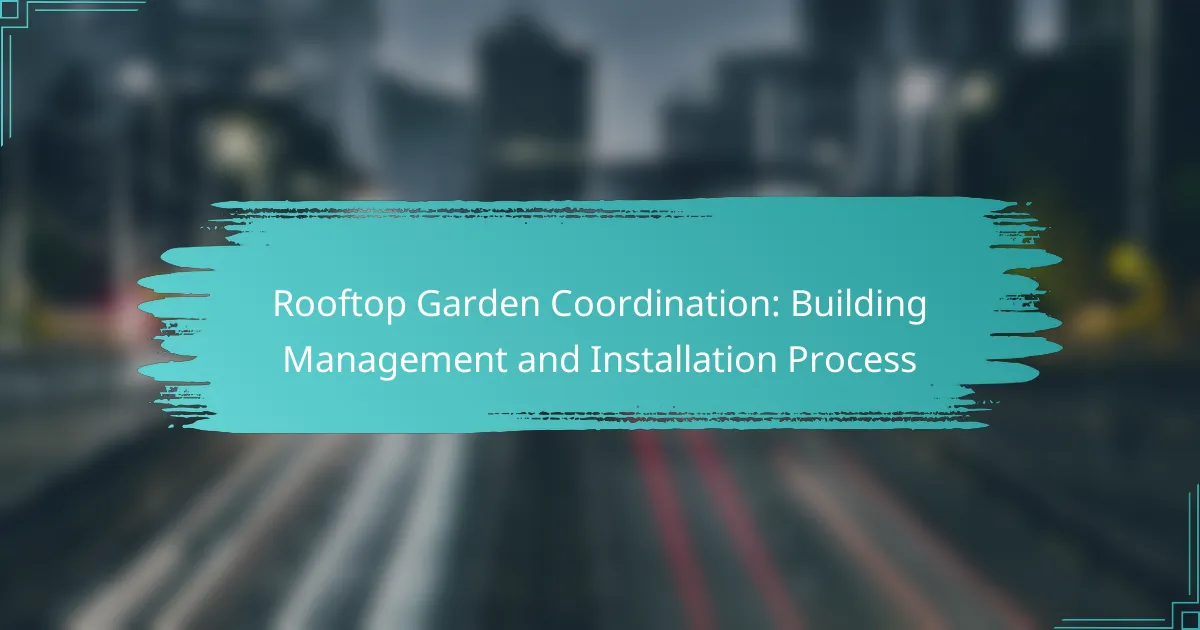Rooftop garden coordination is essential for transforming urban spaces into vibrant green areas that enhance both aesthetics and air quality. Building management plays a crucial role in navigating local regulations and ensuring compliance during the installation process, which includes design, soil preparation, and planting. By implementing best practices, managers can create sustainable gardens that thrive in challenging environments.
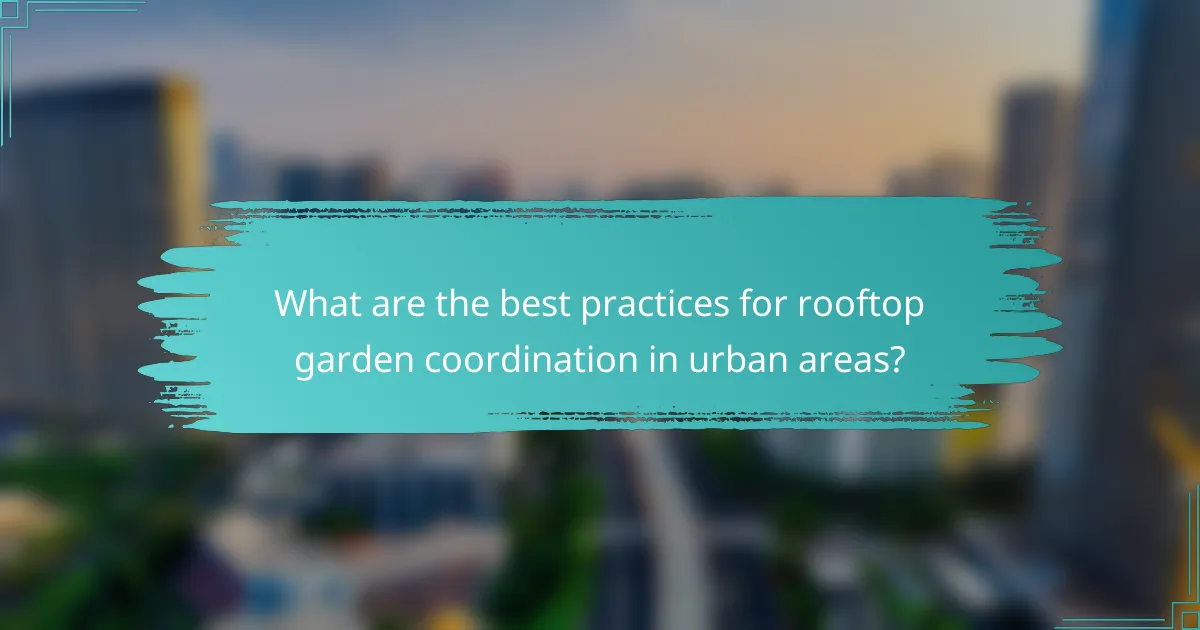
What are the best practices for rooftop garden coordination in urban areas?
Effective rooftop garden coordination in urban areas involves careful planning, selection of suitable plants, and ongoing maintenance. By following best practices, building managers can create sustainable green spaces that enhance aesthetics and improve air quality.
Site assessment and planning
Conducting a thorough site assessment is crucial for successful rooftop garden coordination. Evaluate the structural integrity of the building, ensuring it can support the additional weight of soil and plants. Consider factors such as sunlight exposure, wind patterns, and accessibility for maintenance.
Develop a detailed plan that outlines the layout, plant selection, and water management systems. This plan should also include timelines for installation and maintenance, helping to keep the project organized and on track.
Choosing appropriate plant species
Selecting the right plant species is essential for the success of a rooftop garden. Opt for native plants that are well-adapted to the local climate, as they typically require less water and maintenance. Consider drought-resistant varieties to minimize irrigation needs.
In urban areas, choose plants that can thrive in confined spaces and tolerate pollution. A mix of perennials, shrubs, and small trees can create a diverse ecosystem while providing visual interest throughout the seasons.
Water management systems
Implementing effective water management systems is vital for rooftop gardens. Consider using drip irrigation or rainwater harvesting systems to conserve water and ensure plants receive adequate moisture. These systems can significantly reduce water usage compared to traditional methods.
Regularly monitor soil moisture levels to prevent overwatering or drought stress. Installing a moisture sensor can help automate irrigation, making it easier to maintain optimal conditions for plant growth.
Maintenance schedules
Establishing a maintenance schedule is key to keeping a rooftop garden healthy and vibrant. Regular tasks should include watering, weeding, pruning, and fertilizing plants. Aim for a maintenance frequency that aligns with the specific needs of the chosen plant species.
Consider seasonal adjustments to the maintenance schedule, such as increased watering during hot summer months or preparing plants for winter. Documenting these tasks can help ensure consistency and accountability.
Collaboration with local contractors
Working with local contractors who specialize in green roofs can enhance the coordination of rooftop garden projects. They can provide valuable insights on local regulations, plant selection, and installation techniques that are best suited for the urban environment.
Establish clear communication with contractors to ensure that everyone is aligned on project goals and timelines. Regular check-ins can help address any issues promptly and keep the project progressing smoothly.
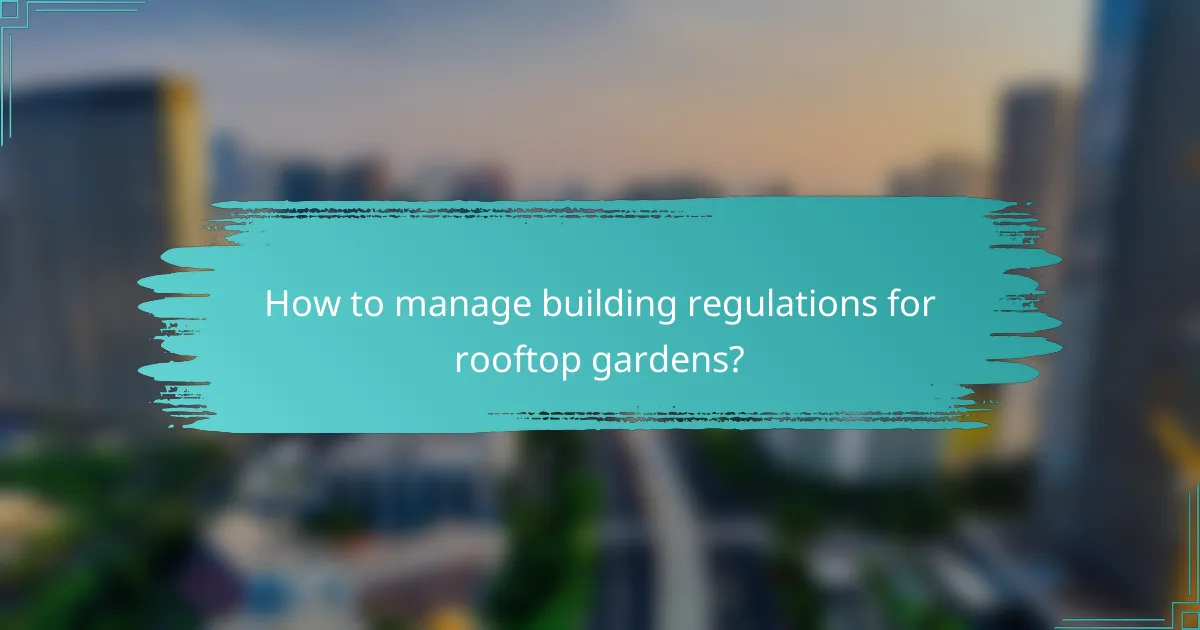
How to manage building regulations for rooftop gardens?
Managing building regulations for rooftop gardens involves understanding local laws and obtaining the necessary permits. Compliance with zoning laws and safety regulations is crucial to ensure that the installation is legal and safe for all residents.
Understanding local zoning laws
Local zoning laws dictate how land can be used, including restrictions on rooftop gardens. These regulations can vary significantly between municipalities, so it’s essential to consult your local zoning office to determine what is permissible.
Common considerations include height restrictions, allowable structures, and the impact on neighboring properties. For instance, some areas may require a certain setback from property lines or limit the types of plants that can be used.
Permitting processes for installations
Obtaining the necessary permits for a rooftop garden typically involves submitting plans to your local building department. This process may include architectural drawings, structural assessments, and environmental impact statements.
It’s advisable to start the permitting process early, as it can take several weeks to months, depending on the complexity of the project and local regulations. Be prepared for inspections and possible modifications to your plans to meet compliance standards.
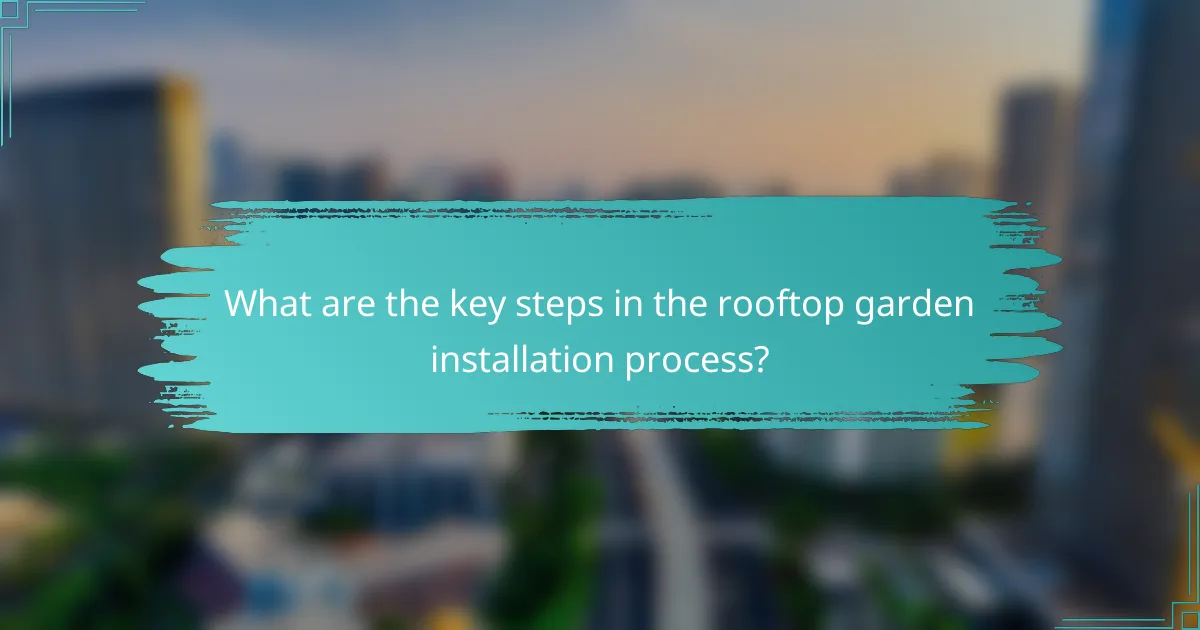
What are the key steps in the rooftop garden installation process?
The rooftop garden installation process involves several critical steps, including design, soil preparation, and planting. Each stage requires careful planning and execution to ensure a successful garden that thrives in an urban environment.
Initial design and layout
The initial design and layout of a rooftop garden are crucial for maximizing space and ensuring structural integrity. Start by assessing the available area, sunlight exposure, and wind patterns to determine the best layout for plants and features.
Consider incorporating raised beds, containers, or vertical gardens to optimize space. Use design software or sketch out your ideas to visualize the arrangement and select appropriate plants based on their light and water needs.
Soil and drainage preparation
Proper soil and drainage preparation is essential for the health of a rooftop garden. Begin by selecting lightweight soil mixes that retain moisture yet provide adequate drainage, typically consisting of organic matter, perlite, and sand.
Install a drainage system to prevent water accumulation, which can damage the building structure. This may include drainage mats or perforated pipes that direct excess water away from the garden area.
Planting and irrigation setup
Once the soil and drainage are prepared, it’s time for planting. Choose plants that are suitable for rooftop environments, such as herbs, succulents, and native species that can withstand wind and limited soil depth.
Set up an irrigation system to ensure consistent watering, which can include drip irrigation or soaker hoses. Regularly monitor moisture levels and adjust the system as needed to maintain healthy plant growth.
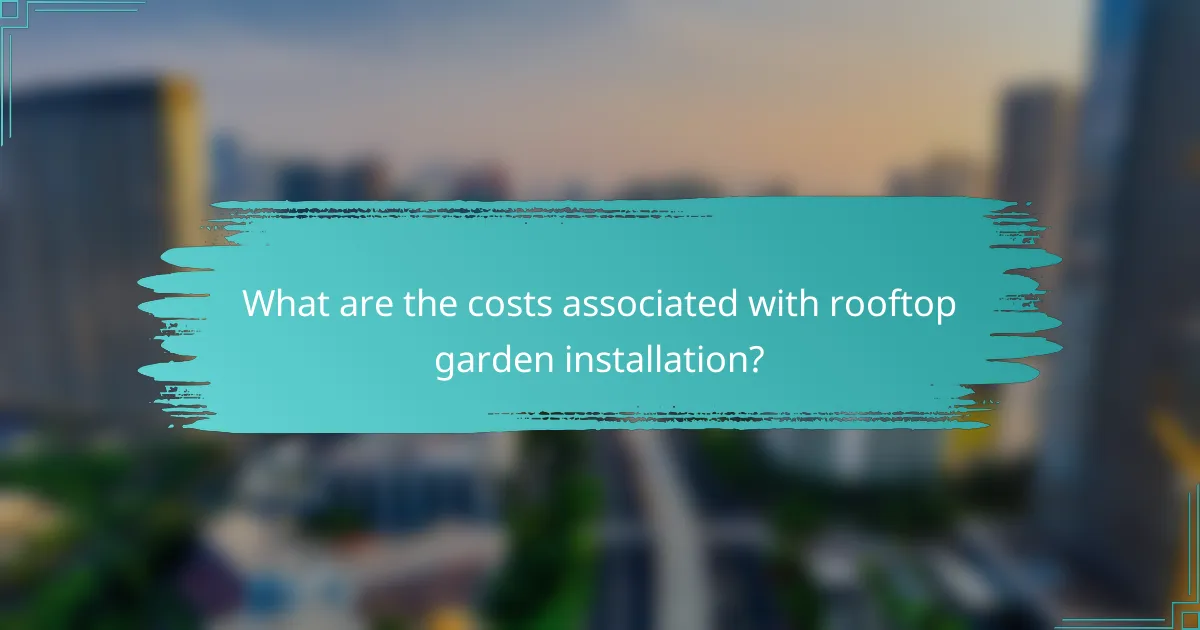
What are the costs associated with rooftop garden installation?
The costs of installing a rooftop garden can vary significantly based on factors such as size, materials, and labor. Generally, you can expect expenses to range from several thousand to tens of thousands of dollars, depending on the complexity of the project.
Material and labor expenses
Material costs for a rooftop garden typically include soil, plants, drainage systems, and structural supports. Depending on the quality and type of materials chosen, these costs can range from a few hundred to several thousand dollars.
Labor expenses can also vary widely. Hiring professional landscapers or garden designers may add significant costs, often ranging from 20% to 50% of the total installation budget. It’s advisable to obtain multiple quotes to ensure competitive pricing.
Ongoing maintenance costs
Ongoing maintenance for a rooftop garden includes watering, pruning, and fertilizing plants, as well as managing drainage systems. Monthly maintenance costs can range from $100 to $500, depending on the size and complexity of the garden.
Consider budgeting for seasonal tasks, such as winterizing plants or replacing dead vegetation, which can incur additional costs. Regular maintenance not only keeps the garden healthy but also helps prevent larger, more costly issues down the line.
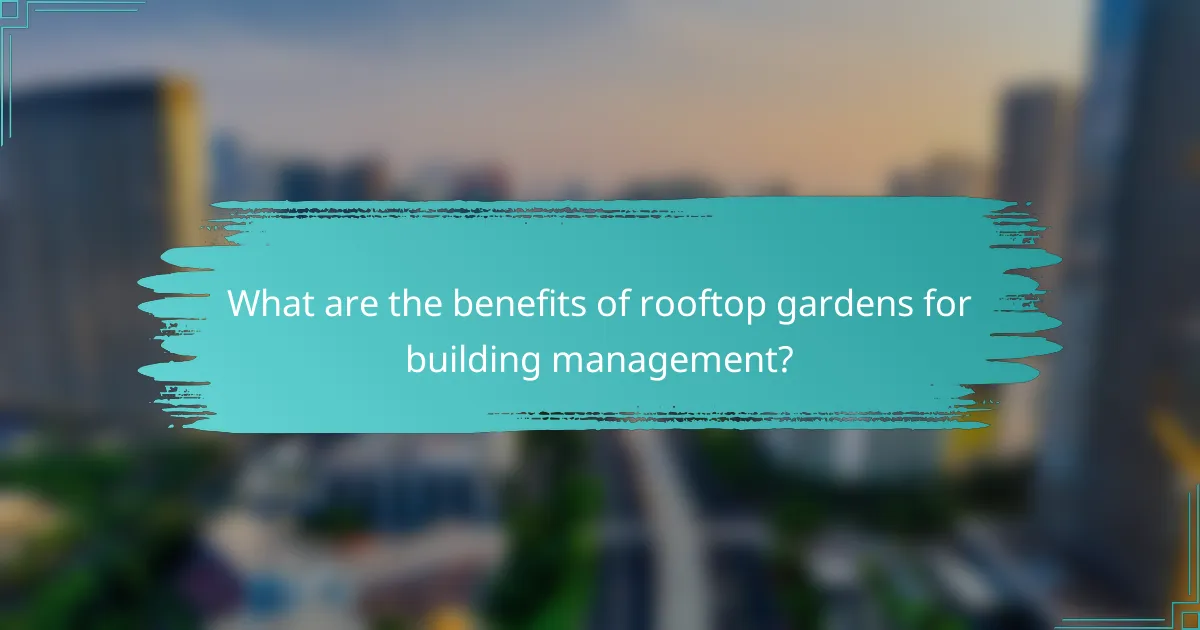
What are the benefits of rooftop gardens for building management?
Rooftop gardens offer significant advantages for building management, including improved energy efficiency, increased property value, and enhanced community engagement. These benefits contribute to sustainability and can lead to cost savings over time.
Energy efficiency improvements
Rooftop gardens can significantly enhance energy efficiency by providing natural insulation. They help reduce heat absorption in buildings, leading to lower cooling costs during warmer months. Studies suggest that buildings with green roofs can experience energy savings of around 20-30% in cooling expenses.
Additionally, the vegetation absorbs sunlight and reduces the urban heat island effect, which can further decrease energy demands. Building managers should consider the local climate when planning a rooftop garden to maximize these benefits.
Enhanced property value
Installing a rooftop garden can increase a property’s market value by enhancing its aesthetic appeal and functionality. Properties with green roofs often attract higher rents and can sell for significantly more than comparable buildings without such features.
Research indicates that properties with rooftop gardens can see value increases of 10-15%. Building owners should evaluate local real estate trends to understand how much value a rooftop garden could add in their specific market.
Community engagement opportunities
Rooftop gardens provide a unique space for community engagement, allowing residents and tenants to connect with nature and each other. They can serve as venues for social events, gardening workshops, or educational programs, fostering a sense of community among building occupants.
By incorporating communal gardening spaces, building management can promote collaboration and enhance tenant satisfaction. It’s essential to involve residents in the planning process to ensure the garden meets their needs and preferences.
